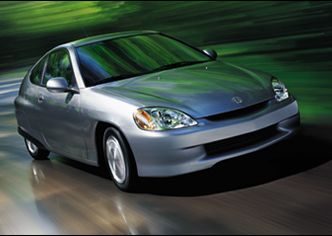
My Car:
The 2000 Honda Insight
| Pros: | The best gas mileage in the world; always draws a crowd. |
| Cons: | Only seats two; no cruise control. |

| Pros: | The best gas mileage in the world; always draws a crowd. |
| Cons: | Only seats two; no cruise control. |
Some Related Links (will open in new browser window):

The Honda Insight is, at least at the time of this writing, a unique motor vehicle.
It's a two-seat hatchback with a radical outward appearance somewhat reminiscent of
an old SAAB 96 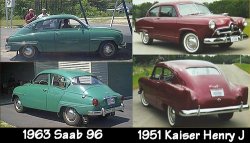 , or even (for you REAL old-timers out there) a Kaiser Henry J (click on the image at left for a larger view of the Insight's ancestors). Some people love its looks, others hate it, but my own opinion is that it looks MUCH better in person than it does in photographs and I love it. Indeed, I once owned a white 1963 SAAB 96 similar to the one in the picture, and I loved it, too!
, or even (for you REAL old-timers out there) a Kaiser Henry J (click on the image at left for a larger view of the Insight's ancestors). Some people love its looks, others hate it, but my own opinion is that it looks MUCH better in person than it does in photographs and I love it. Indeed, I once owned a white 1963 SAAB 96 similar to the one in the picture, and I loved it, too!
But the thing that makes it unique is its hybrid gasoline/electric powerplant consisting of a 67 bph three-cylinder one liter engine and an electric motor that produces 13 bhp located between the engine and transmission. The electric motor doubles ("triples," actually) as the starter motor and as a high power generator that is activated during engine braking and/or whenever the brakes are applied. It is a very simple, elegant design, and it makes the only other hybrid available at this time, the Toyota Prius, seems to be a Rube Goldberg device by comparison.
This hybrid powerplant goes to a standard clutch and a five-speed standard transmission with very long legs -- you can go about 105 in THIRD gear. No automatic is available in the 2000 model, but I understand that a CVT automatic will be available for 2001 as an option.
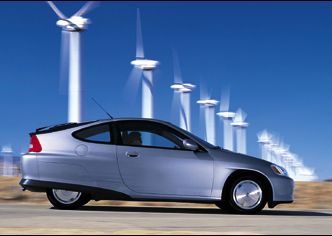 I purchased my Honda Insight in early March, 2000 -- it's one of the first sold in America, with a VIN serial number under 500. It is beautiful, metalflake silver with a black and gray interior. I have put over 30,000 miles on the odometer since then, including all types of driving. I purchased it because gasoline prices were rising alarmingly last March, and I thought that, because the Insight is so heavily subsidized by the manufacturer, it's probably the best deal around for the money.
I purchased my Honda Insight in early March, 2000 -- it's one of the first sold in America, with a VIN serial number under 500. It is beautiful, metalflake silver with a black and gray interior. I have put over 30,000 miles on the odometer since then, including all types of driving. I purchased it because gasoline prices were rising alarmingly last March, and I thought that, because the Insight is so heavily subsidized by the manufacturer, it's probably the best deal around for the money.
It has one, and only one, drawback: It seats two. It seats ONLY two. There is no way to cram anyone else in unless he or she sits on the passenger's lap, and then you will go beyond its published load capacity and will have to cross speed bumps VERY gingerly. There is plenty of room for all the luggage two people would need even for a long trip.
The best thing about it, obviously, is the truly EXTREME gasoline mileage. Overall, including idle time warming up and the time right after I got it when I was tearing around like a testosterone-crazed adolescent, I am averaging around 60 mpg (sometimes it goes a tenth or so above, sometimes a tenth or so below) over the life of the car. For most trips around here, in flat Florida where I live, I get between 75 and 90 mpg. My best run was one day when I drove 144 miles around central Florida with a very light foot and averaged 94.6 mpg. No joke.
The car has a 10.6 gallon tank, so it has a range of over 700 miles. You begin to think of gasoline the way you think of that blue windshield washer liquid, as some fluid level you have to top off every now and again when it gets low. You never think, "Well, I'll have to stop for gas along the way," unless you're driving a couple hundred miles and your tank is already below a quarter full.
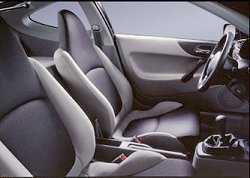 But that's not all that's good about this car. It feels like a very peppy and comfortable
car, not sluggish at all. Because there is GREAT GOBS of room for two people (more head and leg room than I had in my previous car, a Mercedes 420SEL -- I'm 6'2" and very broad of beam), you don't have an awareness that you're driving in a tiny little car at all. This larger car feel is heightened by the uncanny quietness and smoothness of its ride, which is an artifact of its aerodynamics and its long wheelbase and large diameter tires.
But that's not all that's good about this car. It feels like a very peppy and comfortable
car, not sluggish at all. Because there is GREAT GOBS of room for two people (more head and leg room than I had in my previous car, a Mercedes 420SEL -- I'm 6'2" and very broad of beam), you don't have an awareness that you're driving in a tiny little car at all. This larger car feel is heightened by the uncanny quietness and smoothness of its ride, which is an artifact of its aerodynamics and its long wheelbase and large diameter tires.
It requires a little neck bending to get into the rather low car, but once you get in it is very roomy. The Recaro-like seats are exceptionally comfortable, even on the longest trips. I have driven it 900 miles between Cape Canaveral to Washington, D.C. many times, and on one of those trips I drove LITERALLY nonstop from Merritt Island, Florida to Emporia, Virginia, over 700 miles, without any noticeable fatigue or "roadwiggly eyeballs." No other car I know of is capable of such long uninterrupted run up an interstate, but I could probably have made it to Richmond if I hadn't gotten thirsty myself and stopped for a Diet Coke.
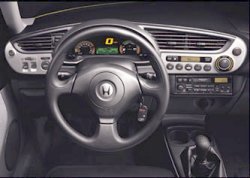 It's surprisingly luxurious, with a high-tech very pleasant digital instrument pod and
all power everything, steering, brakes, mirrors, everything but the seats. The Insight
is no spartan econobox. It has a five-speed transmission and feels just like a normal car
to drive. It even has remote keyless entry, which I really like, but it does not come with
cruise control even as an option, and I miss that.
It's surprisingly luxurious, with a high-tech very pleasant digital instrument pod and
all power everything, steering, brakes, mirrors, everything but the seats. The Insight
is no spartan econobox. It has a five-speed transmission and feels just like a normal car
to drive. It even has remote keyless entry, which I really like, but it does not come with
cruise control even as an option, and I miss that.
It has an adequate base AM/FM/Cassette stereo. The only options are an upgraded radio with CD and a climate control. I got the climate control, which is quite effective and elegant in its operation, and although it only minimally affects performance, it drops my mileage down into the fifties when I use it.
It has an unusual feature called "Auto-Start." When you are going below 19 mph with the car in neutral and your foot on the brake (as when you're approaching a red light), the gasoline engine stops. If you are still rolling and take your foot off the brake it immediately restarts. Once you stop rolling and take your foot off the brake and the clutch it stays stopped until you depress the clutch and put it into gear. Then the gas engine, a 1.0 liter 3-cylinder, restarts when you move off. The operation of this is imperceptible and there is absolutely NO WAY to beat the restart into gear -- I have tried. You get completely used to this very quickly and stop noticing it at all.
One of the strangest things is that the starter motor, which is the electric propulsion motor, is DEAD SILENT, no "rrr-rrr-rrr." When you turn the key you hear and feel nothing; the only way you know the car is running is that the odometer begins to read 1,000 rpm. You NEVER get used to this. It pleases me!
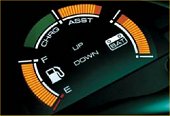 In the dashboard
is a display that shows you the gas tank level and the battery charge level on the two sides of
the display. At the top of the display it shows you whether and how much the battery is
being charged by current use and whether and how much your propulsion is being assisted by
the electric motor. Under full acceleration and full electric assist, which is what you
see in the picture to the left, you can deplete the batteries fairly quickly, within minutes,
in fact. This really doesn't make much difference -- the Insight keeps up with traffic
quite well on the gasoline engine alone, and even while the gasoline engine is charging
the batteries at full tilt.
In the dashboard
is a display that shows you the gas tank level and the battery charge level on the two sides of
the display. At the top of the display it shows you whether and how much the battery is
being charged by current use and whether and how much your propulsion is being assisted by
the electric motor. Under full acceleration and full electric assist, which is what you
see in the picture to the left, you can deplete the batteries fairly quickly, within minutes,
in fact. This really doesn't make much difference -- the Insight keeps up with traffic
quite well on the gasoline engine alone, and even while the gasoline engine is charging
the batteries at full tilt.
It has a little computer that controls the "FCD" ("Fuel Consumption Display") which shows your current gas consumption. It was wise that Honda designed this with a toggle between that display and a more standard odometer because staring at it, and the battery charge/electric assist gauge while you drive becomes a little obsessive, almost like playing Pac Man or something.
It is fairly quick, easily able to dust base Civics, Sentras, Elantras and whatnot at stoplight Grand Prix races, and its tall gearing and aerodynamics give it a very high top speed. (Don't tell anyone but...) I got mine up to 115 mph on I-95 one day trying to "see what this baby will do." It is EXTREMELY stable, almost Mercedes-like, even at the highest speeds.
Its acceleration is more than adequate for any situation, and is better the higher the charge on the battery pack. In normal driving the batteries stay between half and fully charged almost all the time. You can deplete them in spirited driving, but they recharge surprisingly quickly; from a complete discharge they are back to about half-charge within about twelve miles of regular driving. You NEVER have to plug the car in to recharge it, and indeed there is no provision for doing so.
 It is not very good in a slalom. Because of the weight of its 120 D-cell batteries (!)
it's a little ponderous if you try to toss it around like a Porsche. Its handling,
however, is quite adequate even for reasonably spirited country road driving.
It is not very good in a slalom. Because of the weight of its 120 D-cell batteries (!)
it's a little ponderous if you try to toss it around like a Porsche. Its handling,
however, is quite adequate even for reasonably spirited country road driving.
Aside from the extraordinary gas mileage, however, the best thing about this car is the crowds it draws whenever I park it anywhere. People always want to know about it and it's a lot of fun looking at the disbelieving stares on their faces when I tell them about its abilities.
It allegedly meets all 2003 impact standards including side and oblique collision protection, but I don't want to find out anything about that firsthand. It is CARB ULEV certified, so environmentalists can feel smug about themselves.
I have had no mechanical difficulties of any kind in over 30,000 miles, including nine high-speed runs between Cape Canaveral, Florida and Washington, D.C. It requires service at 7,500 mile intervals, and it requires a special 0w-20 oil that for the time being is expensive and is only available at Honda dealers.
Who should buy this car? Anyone who seldom needs to carry more than two people, anyone who has a long commute, anyone who wants to laugh derisively as he or she drives by the neighborhood Amoco, and anyone who wants to feel smug about his personal committment to energy efficiency and environmental protection.
Who should NOT buy this car? Anyone who frequently has to carry more than two people around, and anyone who hates being the object of attention when they drive around or park in a busy parking lot.
Author: Ferguson Foont
![]()
Last Edited: July 10, 2001
Return to Flatworm Home